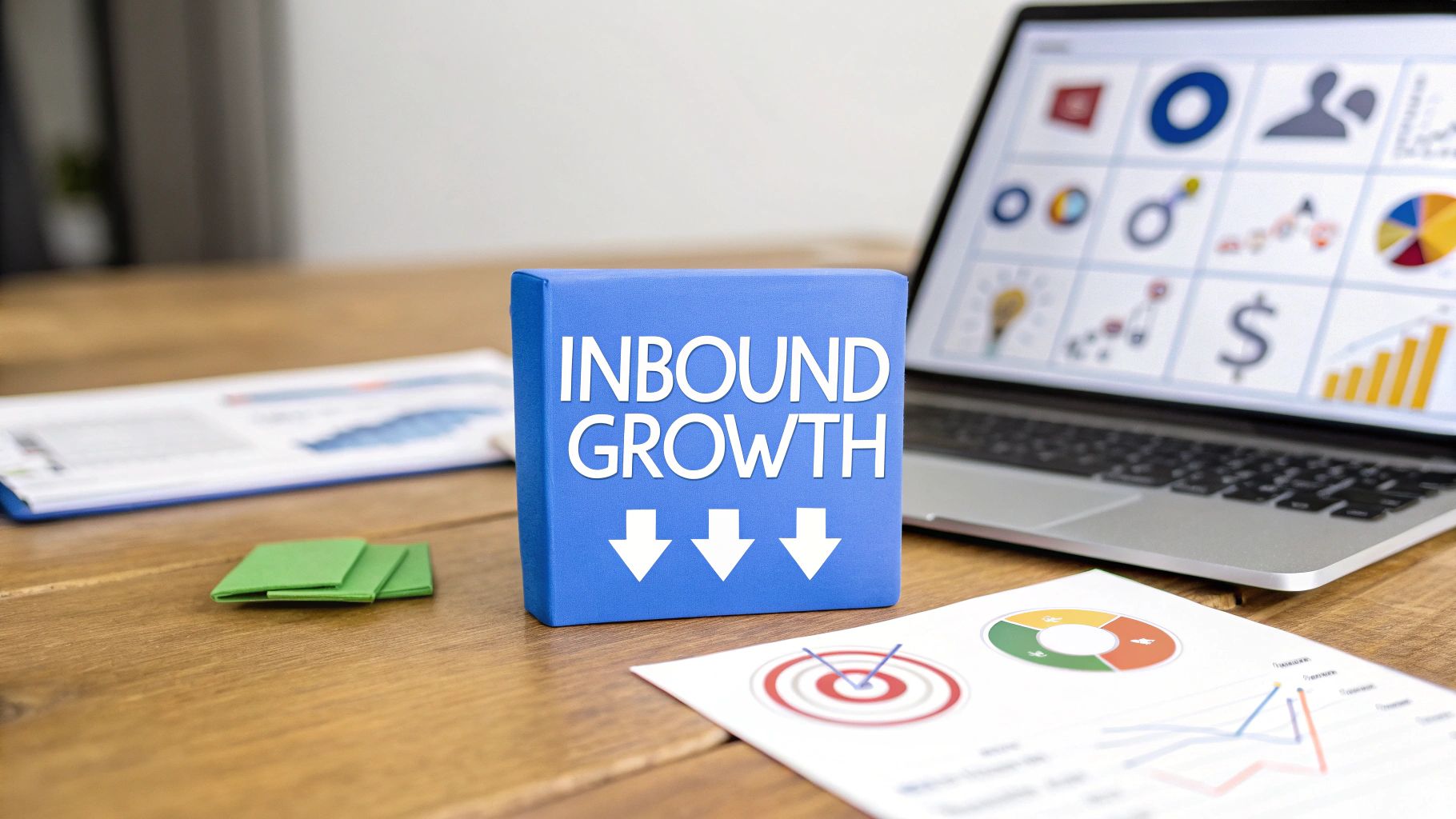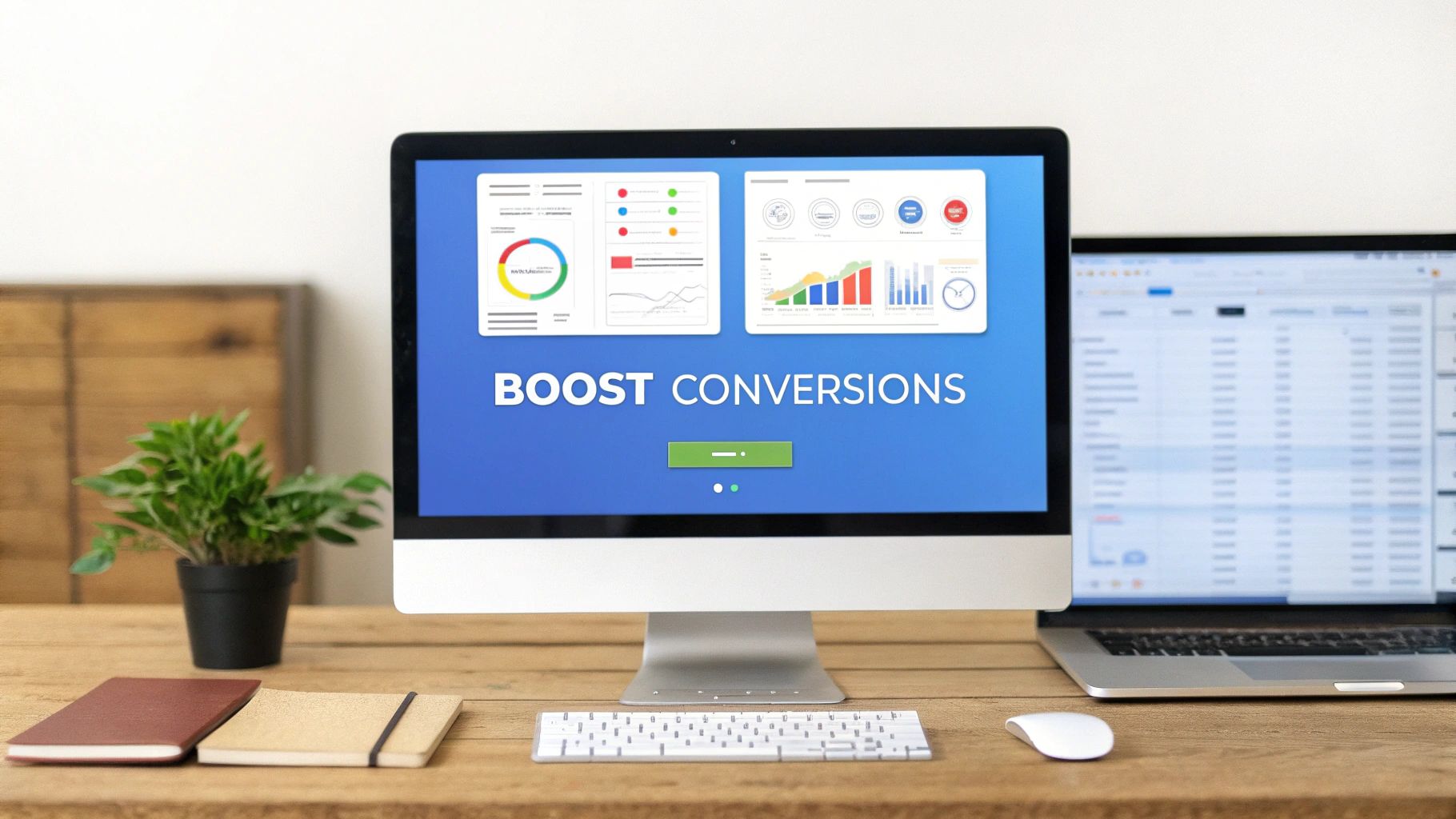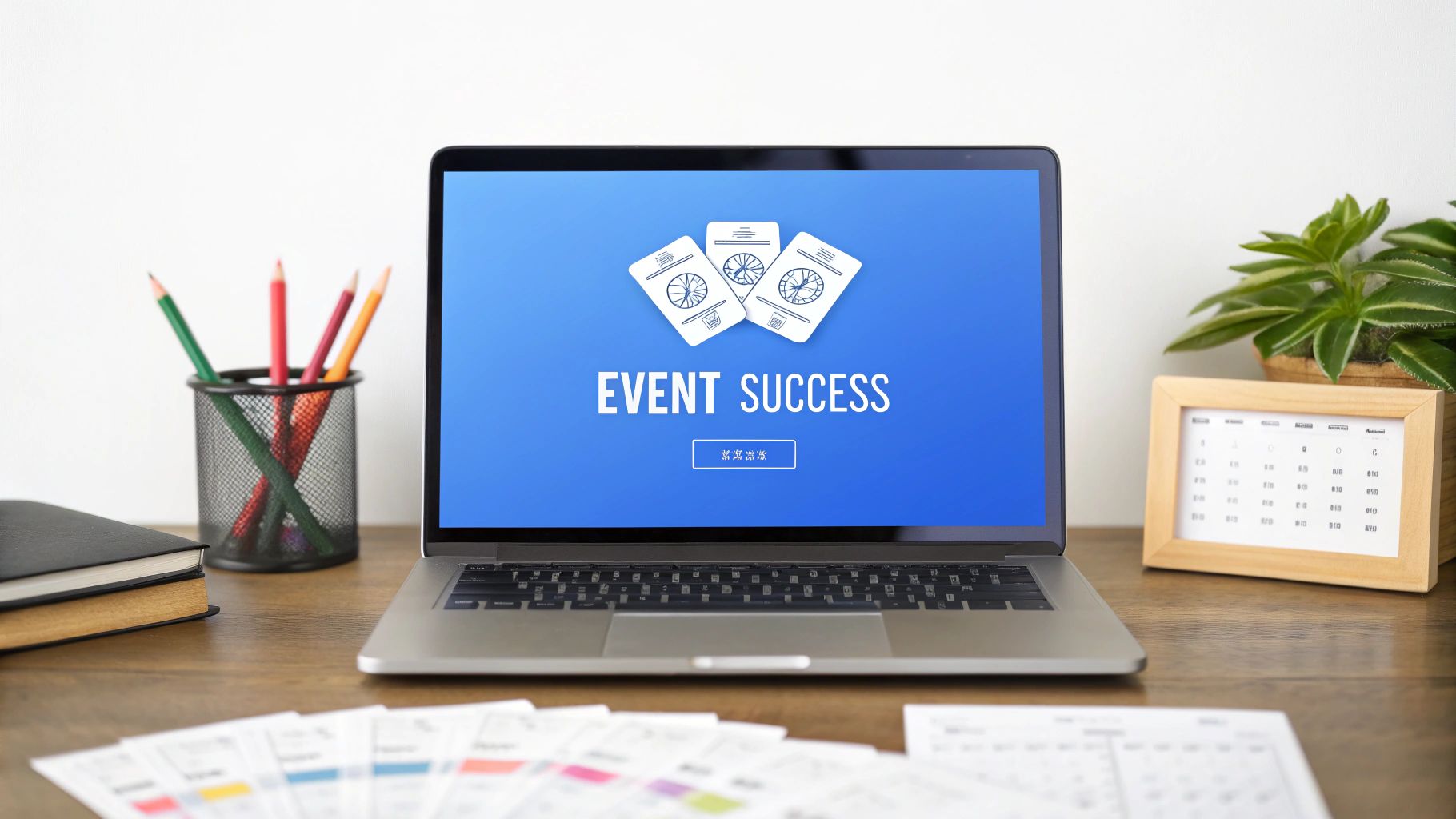Summary
Meta Description: Unlock higher conversions with our guide to A/B testing for landing pages. Learn to form hypotheses, run tests, and analyze data to boost your results.
So, what exactly is A/B testing for landing pages? At its core, it’s a simple method to compare two versions of a web page to see which one performs better. You show one version (the "A" version or control) to one group of your audience and a second version (the "B" variation) to another. Then, you track which one gets more sign-ups, sales, or clicks.
It's a direct conversation with your audience where their actions tell you what works.
Why Smart Marketers Test, Not Guess
Relying on your gut to design a high-converting landing page is like navigating a new city without a map. You might get lucky, but you’re far more likely to get lost.
Smart marketing isn't about guesswork; it’s about making decisions backed by real user behavior. This is exactly where A/B testing becomes your most valuable tool.
Instead of assuming you know what your audience wants, you let their actions provide the answers. Does a bold, benefit-focused headline really beat a question-based one? Does that bright green "Sign Up" button actually get more clicks than a standard blue one? Testing is the only way to know for certain.

From Assumptions to Certainty
Here's the key: every test, whether it’s a huge win or a total flop, gives you priceless insights into your customers' preferences. It transforms your marketing from a series of hopeful guesses into a solid process of continuous improvement. This data-driven approach directly impacts your bottom line.
- Improved User Experience: Testing helps you spot and smooth out friction points, making it incredibly simple for visitors to convert.
- Increased Conversion Rates: Even small, incremental changes discovered through testing can lead to significant lifts in leads and sales over time.
- Lower Acquisition Costs: A higher conversion rate means you’re getting more value from your existing traffic, which lowers the cost to acquire each new customer.
This isn't just a theory; it's standard practice. A whopping 77% of businesses use A/B testing on their websites to sharpen the user experience and drive more conversions. That number shows a clear industry consensus: guesswork just doesn’t cut it anymore.
The Foundation of Growth
Ultimately, A/B testing is the engine that powers conversion rate optimization (CRO). It provides a systematic way to figure out what truly connects with your audience so you can refine your messaging. For a deeper look at the big picture, these essential strategies for website conversion rate optimization lay out a solid framework for turning visitors into customers.
The core idea is powerful: stop debating what might work in a meeting room and start letting your audience's actions guide your decisions. Every test is a conversation with your customers.
This methodical approach is the key to achieving real, measurable success. If you're not testing, you're not learning, and you're leaving money on the table. Grasping this is a critical first step before you can properly learn how to measure marketing campaign success.
High-Impact Elements to Test on Your Landing Page
Deciding where to start can feel overwhelming. To help you focus your efforts, here’s a quick look at the most impactful landing page elements to test and why they are critical for improving conversion rates.
Testing these high-impact elements first gives you the best chance of seeing meaningful results quickly. Ready to pick one and get started?
Setting Up Your First Landing Page Experiment
Every great A/B test starts with a solid, data-backed hypothesis, not just a random idea. Too often, teams jump straight into changing button colors or rewriting headlines without knowing why they're doing it. That's a fast track to wasted time and confusing results.
The real wins come from digging into your data to find a genuine problem—or a hidden opportunity—on your landing page. Then, you can propose a specific, measurable solution.
So, where do you start digging? Don't guess what's wrong; find the evidence. Fire up your analytics and see where people are dropping off. Use heatmaps to see what they're actually clicking on (and what they're ignoring). Dive into customer feedback. Is everyone bailing from your pricing page? Are they not even scrolling far enough to see your main call-to-action? Those are your clues.
How to Form a Powerful Hypothesis
Once you've spotted a potential issue, you need to frame it as a testable hypothesis. The simple "If-Then-Because" framework is perfect. It forces you to connect your proposed change to a clear outcome and, most importantly, a reason.
- If we... (describe the change you're making).
- Then... (state the metric you expect to improve).
- Because... (explain the logic behind your theory).
Let's say your heatmap shows almost nobody is clicking your "Request a Demo" CTA. Your hypothesis could be: "If we change the CTA copy from 'Request a Demo' to 'Watch a 5-Minute Demo Video', then form submissions will increase because visitors are hesitant about a high-commitment live call but are open to watching a short, on-demand video."
See the difference? You've gone from a vague idea like "let's test the CTA" to a focused experiment with a clear definition of success.
Building Your "B" Version
With your hypothesis ready, it's time to build your variation—the "B" in your A/B test. The golden rule here is to test one significant element at a time. If you change the headline, hero image, and the CTA all at once, you'll have no idea which change actually drove the result.
Focus on the changes with the highest potential impact. Here are a few battle-tested elements to consider for your first experiment:
- The Headline: It’s your best shot at grabbing attention. Try testing a benefit-driven headline against one that leans on social proof (e.g., "The #1 Tool for Marketers").
- The Call-to-Action (CTA): Think beyond just the copy. Could a two-step CTA, where the first click opens a pop-up form, outperform a form that's always visible?
- Form Design: The number of fields in your form is a classic conversion killer. Test a simple version that only asks for an email against your current, more detailed one.
- Hero Section Media: Does a video of your product in action work better than a static image? Test a quick product walkthrough against a powerful photo of a happy customer.
This is the basic idea behind any A/B test—splitting your traffic between the original page (Control) and your new version (Variation) to see which one performs better.
The goal of your variation isn't just to be different. It has to be a direct test of your hypothesis. Every change you make should serve the "because" part of that statement.
And if you're just getting started and need to build a solid "A" page first, our guide on creating a high-converting landing page is the perfect place to begin. A strong control version makes your tests far more likely to produce meaningful insights.
Launching Your Test and Collecting Clean Data
You have a solid hypothesis and a new variation ready to go. Now, the real fun begins. Launching your A/B test is more than just flipping a switch—it’s about setting up a proper experiment to collect clean, reliable data. If you get this part wrong, your results will be meaningless.
Your first move is to pick the right A/B testing tool. Platforms like LanderMagic, for example, are designed to make this process incredibly smooth for your paid campaigns, letting you roll out variations quickly without a developer. A good tool does the heavy lifting, like splitting traffic evenly between your control (version A) and your variation (version B), so you can focus on the results.
This flow chart breaks down the core steps of a well-executed A/B test, starting with that crucial research phase all the way through to creating your new challenger.

As the infographic makes clear, every test must begin with solid research and a clear hypothesis. Don't build a variation until you have those nailed down.
Defining Your Conversion Goal
Before you hit "launch," you must know what a "win" looks like. What is your primary conversion goal? Are you aiming for more form fills? An increase in free trial sign-ups? More clicks on that big "Buy Now" button?
Whatever it is, it must be a specific, trackable action. Vague goals like "better engagement" are impossible to measure. Your testing software needs a concrete event to monitor so it can tell you which version is truly performing better.
Reaching Statistical Significance
One of the biggest mistakes marketers make is calling a test too early. It’s tempting. You see one version pulling ahead after a day or two and you get excited. But those early results are often just random noise. To trust your data, you need to hit statistical significance.
It sounds complex, but the concept is simple. It’s just a measure of confidence that your results aren't a fluke. Most tools aim for a 95% confidence level, which means there’s only a 5% chance the outcome is due to random luck.
A test result without statistical significance is just an opinion backed by shaky numbers. Never make a permanent business decision based on it.
So, how long should you let your test run? It depends on your traffic and conversion rate, but here are a few rules to follow:
- Run for at least one full business cycle. For most, that means one to two full weeks. Running a test from Monday to Wednesday ignores how differently people behave over the weekend.
- Aim for enough conversions. Traffic alone isn't enough. You need a meaningful number of conversions on each side. The gold standard is at least 100 conversions per variation.
- Ignore daily spikes and dips. Your conversion rate will bounce around. Don't panic if your variation is losing on Tuesday but winning on Wednesday. Let the test run its course to smooth out these fluctuations.
The goal is to collect enough data to make a confident decision. Stopping early is the fastest way to get misleading results. Let the data mature, hit that 95% confidence level, and you'll have an outcome you can actually trust.
Interpreting Your Results and Making the Call
The test is done. You’ve let it run, gathered the data, and now your dashboard is full of numbers. So, what’s the real story? Figuring out what your A/B test results mean is more than just glancing at the conversion rate—it's about digging into the why behind the numbers.
Your eyes will probably jump straight to the conversion uplift. This is the percentage increase (or decrease) in your variation's performance compared to the original. When you look at that next to your confidence score, you get a clear picture of whether you have a winner. For example, if your Variation B achieved a 15% uplift with 98% confidence, that's a massive signal to roll out the change.
But what if the results are murky? Maybe the uplift is tiny, or your confidence level is sputtering around 80%. This is where the real work begins. A solid grasp of SEO analytics strategies is what helps you make sense of it all and confidently decide what to do next.
Reading Between the Data Points
Not every test wraps up with a clear winner. Your experiment will almost always land in one of three buckets. Knowing how to react to each scenario is what separates the pros from the beginners.
- You Have a Clear Winner: This is the dream scenario. Your new version crushed the original with high statistical significance.
- The Result is Inconclusive: Both versions performed about the same. The confidence score is low, and there’s no obvious winner.
- Your Variation Lost: The original page you were trying to beat actually performed better than your new design.
It’s easy to feel deflated by an inconclusive test or a loss, but you shouldn't. These outcomes are just as valuable as a big win. They show you what your audience doesn't like, saving you from rolling out a change that would have hurt conversions.
Remember, the goal of a/b testing for landing pages isn't just to find winners. It's to learn about your audience. A "failed" test is simply a successful learning opportunity.
The information you pull from these "failures" helps you build a much sharper picture of what truly motivates your customers.
Making the Final Call
Okay, you’ve analyzed the data and you know where your test landed. Now it’s time to act. Your game plan will depend entirely on which of those three scenarios you’re in. This isn’t the time for gut feelings; it’s about making a sharp, data-backed decision.
Here’s a simple checklist for your next steps:
- If You Have a Clear Winner: Don't wait. Push the winning variation live for 100% of your traffic and make it the new control. Document what you learned from the win.
- If the Result is Inconclusive: Your change wasn't big enough to make a real difference. This is your cue to think bigger. Go back to your hypothesis and get bolder. Instead of tweaking a few words, maybe it's time to test a completely different value proposition.
- If Your Variation Lost: This is an incredible learning moment. Your hypothesis was wrong, and now you get to figure out why. Document these insights—they're pure gold for your next test idea. Switch back to your original control and get to work on a new hypothesis.
No matter the outcome, the work is never really done. The final step is always asking, "What's next?" The insights from one test fuel the ideas for the next one, creating a powerful cycle of continuous improvement.
Advanced Strategies for Continuous Optimization
Once you've run a few successful tests, it becomes clear: A/B testing for landing pages isn't just a one-off tactic. It's the engine for a culture of continuous improvement. The real power kicks in when you move beyond simple experiments and start building a strategic program.

This shift is all about mindset. You're moving from reactive, isolated tests to a proactive, long-term testing roadmap. It means planning experiments weeks or even months ahead, focusing on ideas tied to your core business goals, and always having the next test lined up.
Going Beyond Simple A/B Tests
Standard A/B testing is perfect for comparing two different page versions. But what happens when you have several great ideas you want to try at once? That’s where multivariate testing comes in.
Instead of testing a new headline or a new hero image, a multivariate test lets you pit multiple combinations against each other in one go. You could test two headlines and three different CTAs in a single experiment, creating six unique versions. This method needs more traffic, but the payoff is a deeper understanding of how specific elements work together. You learn which combination drives the best results.
Personalizing Your Experiments with Audience Segments
Not all visitors are the same. So why show them all the same landing page? One of the most potent advanced strategies is to start personalizing tests for specific audience segments. Your testing tool can help you slice your traffic based on various user attributes.
Consider these powerful segmentation ideas:
- New vs. Returning Visitors: First-time visitors probably need more social proof. Returning visitors might respond better to loyalty-focused messaging.
- Traffic Source: Someone coming from a Google Ad has a different intent than a person who clicked a link in a LinkedIn article. Test landing page copy that speaks directly to the source.
- Device Type: Mobile users are often distracted and short on time. Try testing a shorter, punchier form for them against the more detailed version you show desktop users.
Segmenting your audience lets you uncover nuanced insights that a broad A/B test would miss. You might discover that one headline is a home run for your paid search traffic but falls flat with your organic audience. That kind of detail is where true optimization happens.
A continuous optimization program isn't just about running more tests; it's about running smarter tests. It's the shift from asking "What works?" to asking "What works for whom?"
Building a Strategic Testing Roadmap
A top-tier testing program doesn’t run on random ideas. It needs a structured roadmap to prioritize experiments based on potential impact versus the effort required.
Here’s a straightforward way to structure your roadmap:
- Gather Ideas: Ideas can come from anywhere—analytics, customer feedback, sales team input, or competitor analysis.
- Score and Prioritize: Rate each idea. A simple PIE framework works wonders: Potential (How big of an impact could this have?), Importance (How critical is this page to our goals?), and Ease (How fast can we launch this?).
- Schedule and Execute: Your highest-scoring ideas go to the top of the list. Get them on a calendar and start building.
This structured approach ensures you’re consistently tackling high-impact experiments. To keep this process organized, you need the right tech. Exploring different landing page optimization tools can help you find a platform that not only runs tests but helps organize your entire workflow.
Common Questions About Landing Page A/B Testing
Even with a solid plan, questions always come up when you get into landing page A/B testing. Let's walk through some of the most common ones.
How Much Traffic Do I Need to Run an A/B Test?
This is a common question, but the honest answer is: it depends. There's no single magic number. The traffic you need is tied directly to your current conversion rate and how big of a lift you expect from your change. A radical headline overhaul will show results much faster than a subtle button color tweak.
As a general rule, a good starting point is to aim for at least 1,000 visitors and 100 conversions per variation. This gives most testing tools enough data to reach statistical significance.
What if my page doesn't get that much traffic? Don't give up. Instead, you just have to aim for bigger changes. Focus on bold, high-impact tests that are more likely to produce a clear winner, like a completely new value proposition or a radical redesign. Small, subtle changes will just get lost in the noise.
For lower-traffic pages, you'll also need to let the test run longer to gather enough data, likely at least four full weeks.
What Are the Most Common A/B Testing Mistakes?
It’s surprisingly easy to run a test that gives you unreliable data. Being aware of the common pitfalls is the first step to getting real value from your experiments.
Here are the top mistakes I see marketers make:
- Ending the test too soon. This is the number one killer of good tests. You see one variation pull ahead early, get excited, and call the test before reaching statistical significance. You have to let the data mature.
- Testing too many elements at once. If you change the headline, hero image, and the CTA in a single test, you'll have no clue which change actually worked. Test one core idea at a time.
- Ignoring losing or inconclusive results. A "failed" test is actually a huge win. It's a learning opportunity that tells you what your audience doesn't respond to, which is incredibly valuable for your next hypothesis.
- Testing without a real hypothesis. Randomly changing elements is like throwing spaghetti at the wall. Your test ideas should always start with data from your analytics, heatmaps, or customer feedback.
Avoid these blunders, and you'll dramatically improve the quality of your insights.
How Do I Decide What to Test First on My Landing Page?
With a dozen ideas floating around, how do you pick a winner? Prioritization is everything. You want to focus on the changes that have the best shot at delivering big wins quickly.
A simple but effective way to do this is with a prioritization framework like PIE (Potential, Importance, Ease).
Ask yourself these three questions for every test idea:
- Potential: How much room for improvement is there? A page with a very low conversion rate has massive potential.
- Importance: How valuable is the traffic to this page? Your most critical, high-traffic landing pages are always the most important.
- Ease: How quickly can we build and launch this test? Swapping a headline is easy; a complete redesign is not.
Start with the ideas that score high marks across the board. These are your "low-hanging fruit," and they're usually the elements "above the fold"—the first things a visitor sees. This means your main headline, hero image, primary call-to-action (CTA), and form complexity are all prime candidates for your first tests.
Ready to stop guessing and start knowing what converts your visitors? LanderMagic makes it simple to build, launch, and analyze powerful landing page experiments for your Google Ads campaigns. Create dynamic, high-converting pages in minutes and see your results soar.









